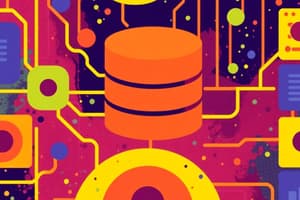Podcast
Questions and Answers
What is the primary difference between data and information?
What is the primary difference between data and information?
- Data is accurate, while information is relevant
- Data is raw, while information is processed (correct)
- Data is timely, while information is key to decision making
- Data is stored, while information is presented
What is the primary purpose of a Database Management System (DBMS)?
What is the primary purpose of a Database Management System (DBMS)?
- To provide a program that interacts with the database
- To provide a collection of related data
- To manage and control access to the database (correct)
- To interact with the database at some point in its execution
What is the term used to describe the practical use of information?
What is the term used to describe the practical use of information?
- Data
- Decision making
- Knowledge (correct)
- Information
What is the primary goal of data management?
What is the primary goal of data management?
What is the term used to describe a collection of application programs that interact with the database?
What is the term used to describe a collection of application programs that interact with the database?
What is the primary benefit of having accurate, relevant, and timely information?
What is the primary benefit of having accurate, relevant, and timely information?
What is the primary limitation of sharing knowledge?
What is the primary limitation of sharing knowledge?
What is the primary characteristic of raw data?
What is the primary characteristic of raw data?
What is the primary benefit of data independence in a DBMS?
What is the primary benefit of data independence in a DBMS?
What is the primary goal of a DBMS in terms of data access?
What is the primary goal of a DBMS in terms of data access?
What is the primary advantage of controlling redundancy in a DBMS?
What is the primary advantage of controlling redundancy in a DBMS?
What is the primary role of a DBMS in terms of data administration?
What is the primary role of a DBMS in terms of data administration?
What is the primary disadvantage of a DBMS in terms of system failures?
What is the primary disadvantage of a DBMS in terms of system failures?
What is the primary reason for the high cost of a large multiuser DBMS?
What is the primary reason for the high cost of a large multiuser DBMS?
What is the primary benefit of a DBMS in terms of concurrent access to data?
What is the primary benefit of a DBMS in terms of concurrent access to data?
What is the primary characteristic of a DBMS in terms of its size?
What is the primary characteristic of a DBMS in terms of its size?
What is the primary responsibility of data administrators in a DBMS environment?
What is the primary responsibility of data administrators in a DBMS environment?
Which factor determines whether a database is classified as single-user or multiuser?
Which factor determines whether a database is classified as single-user or multiuser?
Who is responsible for implementing application programs that provide functionality for end-users in a DBMS environment?
Who is responsible for implementing application programs that provide functionality for end-users in a DBMS environment?
What is the defining feature of a centralized database?
What is the defining feature of a centralized database?
What is the role of database designers in a DBMS environment?
What is the role of database designers in a DBMS environment?
Which component of the DBMS environment includes users of the system?
Which component of the DBMS environment includes users of the system?
What is an expected type of use that might classify a database?
What is an expected type of use that might classify a database?
Which major component of the DBMS environment directly defines and regulates storage?
Which major component of the DBMS environment directly defines and regulates storage?
Why is understanding the characteristics of file systems crucial?
Why is understanding the characteristics of file systems crucial?
What is a primary feature of manual systems in organizations?
What is a primary feature of manual systems in organizations?
What is a major limitation of manual filing systems?
What is a major limitation of manual filing systems?
What was one of the main reasons for developing file-based systems?
What was one of the main reasons for developing file-based systems?
What major approach did file-based systems take compared to a centralized data store?
What major approach did file-based systems take compared to a centralized data store?
What causes the difficulty in accessing data that should be available in file-based systems?
What causes the difficulty in accessing data that should be available in file-based systems?
Which aspect of file-based systems can help prevent future database system problems?
Which aspect of file-based systems can help prevent future database system problems?
What role did Data Processing (DP) staff play in file-based systems?
What role did Data Processing (DP) staff play in file-based systems?
What is one of the primary benefits of a database over disconnected files?
What is one of the primary benefits of a database over disconnected files?
Which statement best describes a database according to the definition provided?
Which statement best describes a database according to the definition provided?
Which of the following is NOT a function of a Database Management System (DBMS)?
Which of the following is NOT a function of a Database Management System (DBMS)?
What is an advantage of having multiple views in a DBMS?
What is an advantage of having multiple views in a DBMS?
Which of the following DBMS software is NOT listed in the provided examples?
Which of the following DBMS software is NOT listed in the provided examples?
By how much can data redundancy be controlled using a DBMS?
By how much can data redundancy be controlled using a DBMS?
What purpose do views serve in DBMS?
What purpose do views serve in DBMS?
Which type of language in a DBMS is used for inserting, updating, deleting, and retrieving data?
Which type of language in a DBMS is used for inserting, updating, deleting, and retrieving data?
Flashcards are hidden until you start studying
Study Notes
Introduction to Databases
- A database is a collection of related data, while a Database Management System (DBMS) manages access to this data.
- Database applications are programs that interact with the database during execution.
- A database system includes application programs, the DBMS, and the database itself.
Data, Information, and Knowledge
- Data consists of raw facts that are unprocessed.
- Information results from processing raw data, providing meaning that aids decision-making.
- Knowledge is the practical use of information, crucial for organizational success.
- Proper formatting of data is essential for effective storage and retrieval.
Evolution of Databases
- Databases have progressed from manual systems to traditional file-based systems and finally to computerized DBMSs.
- Advantages include enhanced data consistency, independence from data representation, and efficient data access.
- Data integrity and security are managed through the DBMS with enforced constraints.
Disadvantages of DBMS
- Complexity in functionality and software development increases DBMS intricacy.
- Size considerations include large storage and memory requirements for efficient operation.
- Greater vulnerability exists due to centralized resource management.
- High costs associated with deployment and additional hardware for large multiuser DBMS.
Database System Components
- Five major components in a DBMS environment: hardware, software, data, procedures, and people.
- Key roles within the database environment:
- Data Administrators: Oversee data management practices.
- Database Designers: Identify data entities, relationships, and storage constraints.
- Application Developers: Create application programs for user functionality.
- End-Users: Clients who utilize the database to meet their information needs.
Classification of Databases
- Databases can be classified by user numbers and location.
- Single-user databases support one user, while multiuser databases accommodate multiple users simultaneously.
- Centralized databases store data at a single site, unlike decentralized systems.
Manual Systems
- Manual systems consist of physical files for organizing internal and external project-related correspondence.
- These systems work effectively for small volumes of data but are inefficient for larger datasets.
File-Based Systems
- An early approach to computerizing manual systems through application programs.
- Each program manages its own data, leading to isolated data that complicates access and management.
- Understanding file-based systems helps identify problems that databases aim to solve, such as data redundancy and separation.
Database Management Systems (DBMS)
- A DBMS enables users to define, create, maintain, and control access to databases.
- Common DBMS examples include MySQL, PostgreSQL, Microsoft Access, and Oracle.
- DBMS capabilities include:
- Data Definition Language (DDL) for database structure management.
- Data Manipulation Language (DML) for data operations like insertion and retrieval.
- Data Control Language (DCL) for managing access to data.
- Views to simplify data presentation, enhance security, and allow customization.
Advantages of DBMS
- Reduces data redundancy by integrating files to prevent multiple storage copies.
Studying That Suits You
Use AI to generate personalized quizzes and flashcards to suit your learning preferences.




